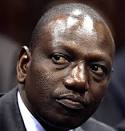While Trump Tweets, the ‘Cold Monster’ Returns by Amir Taheri

How is Donald Trump doing?In the past couple of weeks, this question has been making the rounds in political and punditry circles pondering the first six months of the new US President.
The answer depends on whose point of view one has in mind. From Trump’s point of view things are going well for him. He has managed to keep himself at the center of global media coverage almost non-stop, thus satisfying his seemingly insatiable craving for attention. At the same time, he has made it impossible for political foes to challenge him in the field of policies. Not doing anything in that field, he is not exposed to scrutiny and criticism. To avoid being labeled as a do-nothing president, however, he fills the policy vacuum with a deluge of tweets and an avalanche of executive orders while highlighting his few surprising successes, including the ability to name a man of his choice to the US Supreme Court.
Trump has turned the political debate in the US into what sociologist Malinowski calls “phatic communion” or “content-less conversation”, a process solely aimed at keeping the conversation going without conveying any discernible meaning — something like what Irish dramatist Samuel Beckett did in his plays.
The Trump method, if one might call it thus, has two planks.
The first is to foment confusion regarding his public and private personae. All public performers usually have two faces: a phony one in public and a real one in private. In Trump’s case however, it is the public face that is genuine and the private one that is phony, as French President Emmanuel Macron and Russian President Vladimir Putin recently discovered.
The second plank of Trump’s method is to hide what matters through over-exposure. The model for that is Edgar Allen Poe’s short story “The Purloined Letter” in which Auguste Dupin, the best of French detectives, has to employ all his resources to discover a compromising letter that is so much in evidence that no one notices it. Because everyone sees what Trump is doing, or believes they see what he is doing, no one actually knows what he is doing. That offers him a luxury that few previous US presidents enjoyed, that of escaping the trap of predictability.
More importantly, perhaps, Trump has managed to maintain his original support base almost intact. The latest polls in July showed that his approval rating remains at around 39 percent, the lowest for any president in his first year, but surprisingly close to the base that swept him into the White Hose.
By all accounts, Trump’s presidency is an unusual one because Trump himself is an unusual occupant of the White House. He is the first non-politician to win the presidency since Dwight D. Eisenhower in 1952. He is also the first to enter the White House without the active backing of either of the two big parties.
In Washington, the conventional wisdom is that the Trump presidency has already failed and that a change at the top in the White House is only a matter of time.
I am not so sure. Politically, no potential alternative to Trump, Republican or Democrat, could garner a similar support base at this moment. Deeply divided, Americans seem to be getting used to the new version of the Punch-and-Judy show in Washington, and trying to live and better their lives as if government were on auto-pilot.
Government on auto-pilot should not be dismissed out of hand as if it were a misfortune. In fact, there are many examples in history, including the American story itself, of good results emanating from auto-pilot.
President Bill Clinton’s second term was an overall success by all accounts, largely because the auto-pilot was working, while the White House was dealing with Monica-gate and the Republicans pursuing their dream of impeaching him.
In contrast, the US passed through one of its most humiliating phases under Jimmy Carter, the most active and hands-on president in the past 100 years.
Trump succeeded Barack Obama, another hands-on president, one of whose aims was to counter the traditional working mechanisms of the US government. One example: He insisted that the firing of a missile by an Apache helicopter against terrorist bases in Iraq be first cleared with him in Washington. Obama also took pleasure in publicly contradicting, thus humiliating, his own top aides, including the hapless John Kerry, by reversing policies developed by the American machinery of state.
In contrast, Trump, while playing his TV-show “you-are-fired game” with his close entourage, most recently with the Italian-American loudmouth Antonio Scaramucci, has steered clear of intervening in the workings of the American machinery of state, the invisible power that the French label “the cold monster”. It may take many more months, if not years, for that “cold monster” to regain the self-confidence and agility it lost under Obama. But the process has already started in the Pentagon, the CIA, the Treasury and the Permanent Legation at the UN. The State Department is the only major part of the “cold monster” that has not yet recovered from the shock of the Obama years.
Auto-pilot is also working on the economic front. Projected growth rates for the final quarter of 2017 hover close to 2 percent compared to .05 in the comparable period last year. Although job growth was slowing down, the US unemployment rate in June dropped to 4.3 percent, the lowest in 16 years. The US dollar also seems to have benefited from auto-pilot, rising against all main currencies, including the euro and the sterling.
Auto-pilot is also doing well on issues of more concern to Trumps’ support base, notably immigration, with the monthly number of expelled “undocumented illegals almost double that of 2016.”
Where auto-pilot isn’t really interested, including on such childish schemes as building a wall on the Mexican border or expelling transgenders from the armed forces, nothing happens beyond the president’s tweets. Nor does “the cold monster” take any notice of Trump’s seemingly conciliatory, not to say flattering, remarks when meeting Putin, Macron or British Prime Minister Theresa May.
Trump may end up doing damage to the presidency as an institution by further de-sacralising — not to say demeaning — it. But that could help other institutions, the Congress and the Supreme Court more specifically, to regain part of the strength they lost under Obama.
Each presidency develops a grammar of its own which, if not understood, would make its proper assessment difficult. Trump’s is no exception. So far, it has allowed the US machinery of state — the “cold monster” — to enter a period of convalescence to recover from the shock of the Obama years. That may not be a success for Trump, but it certainly is for the US.
 (Image source: White House/Wikimedia Commons) (Image source: White House/Wikimedia Commons) |
Amir Taheri, formerly editor of Iran’s premier newspaper, Kayhan, before the Iranian revolution of 1979, is a prominent author based on Europe. He is the Chairman of Gatestone Europe.
This article first appeared in Asharq Al Awsat and is reprinted here with the kind permission of the author.























